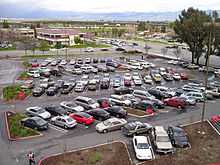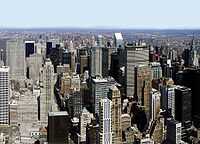Impervious surface

Impervious surfaces are mainly artificial structures—such as pavements (roads, sidewalks, driveways and parking lots) that are covered by impenetrable materials such as asphalt, concrete, brick, and stone--and rooftops. Soils compacted by urban development are also highly impervious.
Environmental effects of impervious surfaces
Impervious surfaces are an environmental concern because, with their construction, a chain of events is initiated that modifies urban air and water resources:
- The pavement materials seal the soil surface, eliminating rainwater infiltration and natural groundwater recharge. From a recent article in the Seattle Times: "While urban areas cover only 3 percent of the U.S., it is estimated that their runoff is the primary source of pollution in 13 percent of rivers, 18 percent of lakes and 32 percent of estuaries."[1]
- Some of these pollutants include excess nutrients from fertilizers; pathogens pet waste; gasoline, motor oil, and heavy metals from vehicles; high sediment loads from stream bed erosion and construction sites, and waste such as cigarette butts, 6-pack holders and plastic bags carried by surges of stormwater. In some cities, the flood waters get into combined sewers, causing them to overflow, flushing their raw sewage into streams. Polluted runoff can have many negative effects on fish, animals, plants and people.
- Impervious surfaces collect solar heat in their dense mass. When the heat is released, it raises air temperatures, producing urban "heat islands", and increasing energy consumption in buildings. The warm runoff from impervious surfaces reduces dissolved oxygen in stream water, making life difficult in aquatic ecosystems.
- Impervious pavements deprive tree roots of aeration, eliminating the "urban forest" and the canopy shade that would otherwise moderate urban climate. Because impervious surfaces displace living vegetation, they reduce ecological productivity, and interrupt atmospheric carbon cycling.

The total coverage by impervious surfaces in an area, such as a municipality or a watershed is usually expressed as a percentage of the total land area. The coverage increases with rising urbanization. In rural areas, impervious cover may only be one or two percent. In residential areas, coverage increases from about 10 percent in low-density subdivisions to over 50 percent in multi-family communities. In industrial and commercial areas, coverage rises above 70 percent. In regional shopping centers and dense urban areas, it is over 90 percent. In the contiguous 48 states of the USA, urban impervious cover adds up to 43,000 square miles (110,000 km²) — an area nearly the size of the State of Ohio. Continuing development adds another quarter of a million acres (1,000 km²) each year. Typically two-thirds of the cover is pavements and one-third is building roofs.[2]
Mitigation of environmental impacts
Impervious surface coverage can be limited by restricting land use density (such as number of homes per acre in a subdivision), but this approach causes land elsewhere (outside the subdivision) to be developed, to accommodate growing population. (See urban sprawl.) Alternatively, urban structures can be built differently to make them function more like naturally pervious soils; examples of such alternative structures are porous pavements, green roofs and infiltration basins.
Rainwater from impervious surfaces can be collected in rainwater tanks and used in place of main water.
Partly in response to recent criticism by municipalities, a number of concrete manufacturers such as CEMEX and Quikrete have begun producing permeable materials which partly mitigate the environmental impact of conventional impervious concrete. These new materials are composed of various combinations of naturally derived solids including fine to coarse-grained rocks and minerals, organic matter (including living organisms), ice, weathered rock and precipitates, liquids primarily water solutions, and gases.[3]
Percentage imperviousness (PIMP)
The percentage imperviousness, often referred to as PIMP in calculations, is an important factor when considering drainage of water. It is calculated by measuring the percentage of a catchment area which is made up of impervious surfaces such as roads, roofs and other paved surfaces. An estimation of PIMP is given by PIMP = 6.4J^0.5 where J is the number of dwellings per hectare (Butler and Davies 2000). For example, woodland has a PIMP value of 10%, whereas dense commercial areas have a PIMP value of 100%. This variable is used in the Flood Estimation Handbook.
See also
- Bioswale
- Hardscape
- Hydraulic conductivity
- Hydrophobic soil
- Permeability (fluid)
- Soil crust
- Sustainable urban drainage systems
References
- ↑ Cappiello, Dina. "Report: EPA Failing to stop Sprawl Runoff." Seattle Times, 16 Oct. 2008
- ↑ Schueler, Thomas R. "The Importance of Imperviousness." Reprinted in The Practice of Watershed Protection. 2000. Center for Watershed Protection. Ellicott City, MD.
- ↑ Rosenberg, Carter, 2006, Anti-Impervious Surfaces: The Ecological Impact of Concrete Alternatives, Troy, NY: Luminopf Press.
Bibliography
- Butler, D. and Davies, J.W., 2000, Urban Drainage, London: Spon.
- Ferguson, Bruce K., 2005, Porous Pavements, Boca Raton: CRC Press.
- Frazer, Lance, 2005, Paving Paradise: The Peril of Impervious Surfaces, Environmental Health Perspectives, Vol. 113, No. 7, pg. A457-A462.
- U.S. Environmental Protection Agency. Washington, DC. "After the Storm." Document No. EPA 833-B-03-002. January 2003.